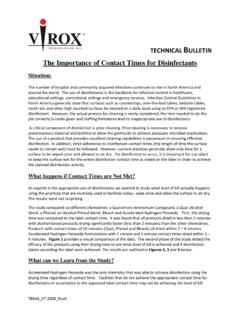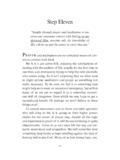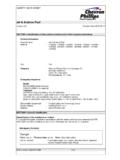Transcription of Tobacco Questions for Surveys - World Health Organization
1 Tobacco Questions for SurveysA Subset of Key Questions from the Global Adult Tobacco survey (GATS)2nd Edition GTSSGLOBAL Tobacco SURVEILLANCE SYSTEMT obacco Questions for SurveysA Subset of Key Questions from the Global Adult Tobacco survey (GATS)2nd Edition GTSSGLOBAL Tobacco SURVEILLANCE SYSTEMT obacco Questions for SurveysA Subset of Key Questions from the Global Adult Tobacco survey (GATS)2nd Edition GTSSGLOBAL Tobacco SURVEILLANCE SYSTEMS uggested Citation:Global Adult Tobacco survey Collaborative Group. Tobacco Questions for Surveys : A Subset of Key Questions from the Global Adult Tobacco survey (GATS), 2nd Edition. Atlanta, GA: Centers for Disease Control and Prevention, PageGlobal Tobacco Surveillance System ..vPreface ..11. Why Use Standardized Questions in Tobacco Surveys ?
2 22. Overview of the Tobacco Questions ..33. Measuring Tobacco Smoking Prevalence ..64. Monitor: Tobacco Smoking Consumption ..85. Monitor: Smokeless Tobacco Use ..106. Protect: Exposure to Secondhand Smoke ..127. Offer: Cessation ..148. Warn: Anti-Cigarette Information ..169. Enforce: Cigarette Advertisements ..2010. Raise: Economics ..2211. Analysis of Tobacco Questions ..24 Appendix A: GATS Overview ..35 Appendix B: GATS Questionnaire Development Background ..37 Appendix C: question Mapping to GATS ..39 Acknowledgements ..40 Contact Information ..41ivtablesTable PageTable 2-1. Measuring Tobacco Smoking Prevalence ..3 Table 2-2. Measuring Key Aspects of Tobacco Surveillance ..4 Table 11-1. Detailed Smoking Status by Gender ..24 Table 11-2.
3 Current Smokers of Various Smoked Tobacco Products, by Selected Demographic Characteristics ..25 Table 11-3. Cigarettes Smoked per Day Among Daily Cigarette Smokers, by Selected Demographic Characteristics ..26 Table 11-4. Detailed Smokeless Tobacco Use Status by Gender ..27 Table 11-5. Exposure to Tobacco Smoke at Home, by Smoking Status and Selected Demographic Characteristics ..28 Table 11-6. Exposure to Tobacco Smoke at Indoor Work Areas, by Smoking Status and Selected Demographic Characteristics ..29 Table 11-7. Current Smokers who Made a Quit Attempt and Received Health Care Provider Assistance in the Past 12 Months, by Selected Demographic Characteristics ..30 Table 11-8. Noticing Anti-Cigarette Smoking Information During the Last 30 Days in Newspapers or Magazines and Television, by Smoking Status and Selected Demographic Characteristics.
4 31 Table 11-9. Current Smokers who Noticed Health Warnings on Cigarette Packages and Considered Quitting Because of the Warnings During the Last 30 Days, by Selected Demographic Characteristics ..32 Table 11-10. Noticing Cigarette Advertising During the Last 30 Days in Various Places, by Selected Demographic Characteristics ..33 Table 11-11. Average Amount Spent on a Pack of Cigarettes and Cost of 100 Packs of Cigarettes as a Percentage of Gross Domestic Product (GDP) per Capita ..34vGlobal Tobacco surveillanCe systemIn 1998, the World Health Organization (WHO), the Centers for Disease Control and Prevention (CDC), and partners initiated the Global Tobacco Surveillance System (GTSS) to assist countries in establishing Tobacco control surveillance and monitoring programs.
5 GTSS includes collection of data through three school-based Surveys : the Global Youth Tobacco survey (GYTS), the Global School Personnel survey (GSPS), and the Global Health Professions Student survey (GHPSS), and one household survey : the Global Adult Tobacco survey (GATS). GTSS provides a consistent framework for surveillance including standard sampling procedures, core questionnaire items, training in field procedures, data analysis, and consistent reporting across all participating countries. GTSS also enhances the role of government and the nongovernmental sector in surveillance, monitoring of Tobacco use and key Tobacco control indicators, and policy and program interventions. The synergy between countries passing Tobacco control laws, regulations or decrees, ratifying and complying with the WHO Framework Convention on Tobacco Control, and conducting GTSS Surveys offers opportunities to develop, implement, and evaluate comprehensive Tobacco control reflects WHO s, CDC s and partners ongoing efforts to establish Tobacco control surveillance and monitoring programs to track trends over time in Tobacco -related knowledge, attitudes, behaviors and environmental document Tobacco Questions for Surveys has been prepared for Surveys that want to include Questions on Tobacco .
6 If national and sub-national Surveys use the Questions and response categories in this guide, this will help to improve survey comparability over time and harmonize them with international Tobacco surveillance and monitoring survey Questions in this guide are taken from the Global Adult Tobacco survey (GATS) questionnaire. GATS was developed to provide a global standard protocol for consistent monitoring of adult Tobacco use. GATS is designed to produce national and sub-national estimates on Tobacco use, exposure to secondhand smoke, and quit attempts among adults across countries and indirectly measure the impact of Tobacco control and prevention initiatives. GATS is intended to assist countries to design, implement and evaluate Tobacco control and prevention programs.
7 GATS is a nationally representative household survey of all non-institutionalized men and women aged 15 years and older. It uses a standard and consistent core questionnaire, sample design, and data collection and management techniques that were reviewed and approved by the review committees comprised of experts from developed and developing countries. A detailed overview of GATS can be found in Appendix A. The GATS Core Questionnaire was constructed by Tobacco control and survey design experts and has undergone rigorous development and testing, which is outlined in Appendix B. The Questions in this guide are mapped to the GATS Core Questionnaire in Appendix C. In order to maintain consistency and comparability in monitoring Tobacco use, a standard set of survey Questions on Tobacco use should be implemented across various Surveys , and should be periodically monitored.
8 Given this important need, GATS partners have created the Tobacco Questions for Surveys booklet that includes a subset of key survey Questions from the GATS for other Surveys to include. Surveys can select indicators and corresponding Questions from this list to include based on their particular focus or priority, or incorporate the complete set if guide: fExplains why it is important to adopt a standard set of Tobacco Questions in Surveys . fIntroduces the set of Questions on Tobacco and the corresponding analysis indicators including: Tobacco smoking prevalence Questions , which are essential in monitoring smoking rates. Additional Questions covering key aspects of Tobacco use and policies. fProvides definitions and instructions for administering the Questions .
9 FExplains how survey data from the Questions are used to estimate key Tobacco Why use standardized Questions in Tobacco Surveys ? Tobacco use is a major preventable cause of premature death and disease worldwide. Just over five million people die each year due to Tobacco -related illnesses a figure expected to increase to more than eight million a year by 2030. Unless the current trend is changed, the vast majority of these deaths are projected to occur in the developing World . The WHO Framework Convention on Tobacco Control (WHO FCTC) was developed in response to the globalization of the Tobacco epidemic. The WHO FCTC and its guidelines provide the foundation for countries to implement and manage Tobacco control, and sets the baseline for reducing both demand for and supply of assist countries in meeting the WHO FCTC requirements, WHO introduced MPOWER, a package of selected demand reduction measures contained in the WHO FCTC.
10 (Further information about WHO s Tobacco Free Initiative can be found at )Monitor Tobacco use and prevention policiesProtect people from Tobacco smokeOffer help to quit Tobacco useWarn about the dangers of tobaccoEnforce bans on Tobacco advertising, promotion, and sponsorshipRaise taxes on of the essential components of a comprehensive global Tobacco control effort is an efficient and systematic surveillance mechanism to monitor the epidemic. This is also emphasized by Article 20 (Research, surveillance and exchange of information) and Article 21 (Reporting and exchange of information) of the WHO FCTC. In order to maintain consistency and comparability in monitoring Tobacco use, a standard set of Tobacco use survey Questions should be implemented across various surveillance activities.

















